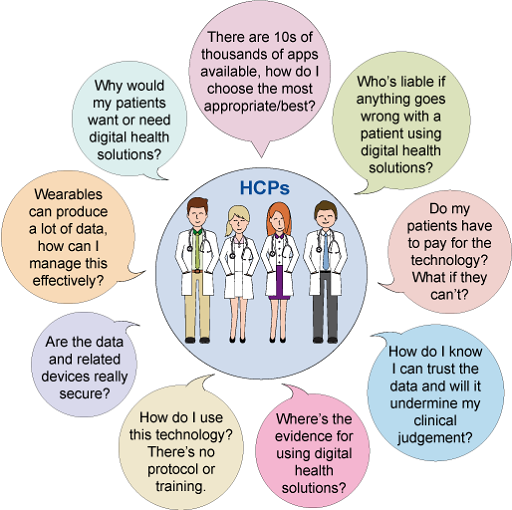4 Critical perspectives on incorporating technology
Professionals may have a number of criticisms or questions about the use of technology in care. For example, some professionals may feel that they cannot offer the same quality of care if they are delivering some aspects of it digitally (such as responding to a service user via email rather than verbally or face-to-face). This highlights how not all critical perspectives on the role of technology are about resistance to change or not being comfortable with new technology. Take a look at the figure below (Deloitte, 2015) to see some common questions that professionals might have about technology changing care.
In the next activity, you will be asked to read results from an intervention study about telemonitoring in Scotland to get a detailed idea about the experiences of healthcare staff during a digital intervention.
Activity 3 Delving into problems with digital interventions
In this activity, you will be asked to read the findings of an intervention study and then reflect on them. The article, ‘Telemonitoring for chronic heart failure: the views of patients and healthcare professionals – a qualitative study’ [Tip: hold Ctrl and click a link to open it in a new tab. (Hide tip)] , describes a telemonitoring intervention in Scotland for people with chronic heart conditions. As you read, note answers to the following questions:
- Why might patients’ levels of confidence in telemonitoring be misplaced?
- Why might the anticipated cost savings of telemarketing not be realised?
- What suggestions are made for developing the service successfully in the future?
Discussion
- A high degree of confidence was expressed by patients because there was an over estimation of the consistency of monitoring and speed of potential response by healthcare professionals.
- While there could be savings on the costs of hospital admission as a result of using telemonitoring, healthcare practitioners are concerned that these may be outweighed by the cost of the equipment, installation and maintenance costs and the cost of training and support for those running the system.
- Professionals emphasised the need for effective leadership and professional development, there is a need for the active involvement and engagement of stakeholders and systems are needed to ensure regular feedback and evaluation from patients in particular.
In this section, you have learned about some of the challenges in changing practice through digital and technological change. Such technological interventions have clear implications and repercussions for professional practice and it is useful to delve a bit deeper into these promises and pitfalls to ensure that services change in positive ways. From the activity, you have had the chance to see how important it is to offer staff the opportunity to reflect and feedback on changes as there may be some negatives that have not been foreseen at the time of the digital and technological change or intervention.

